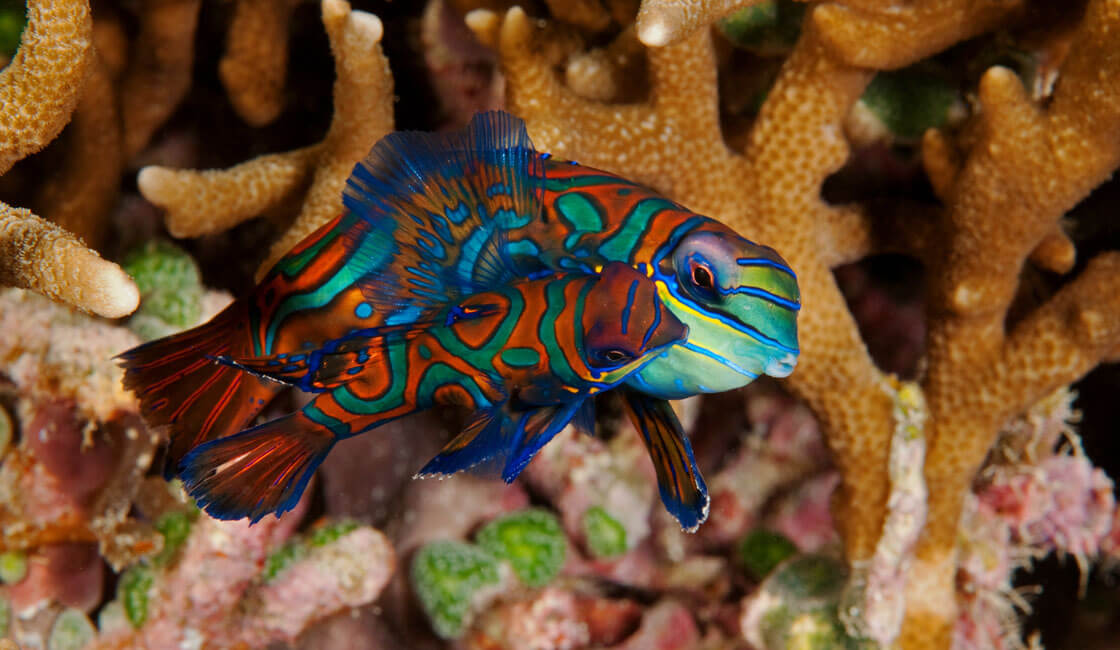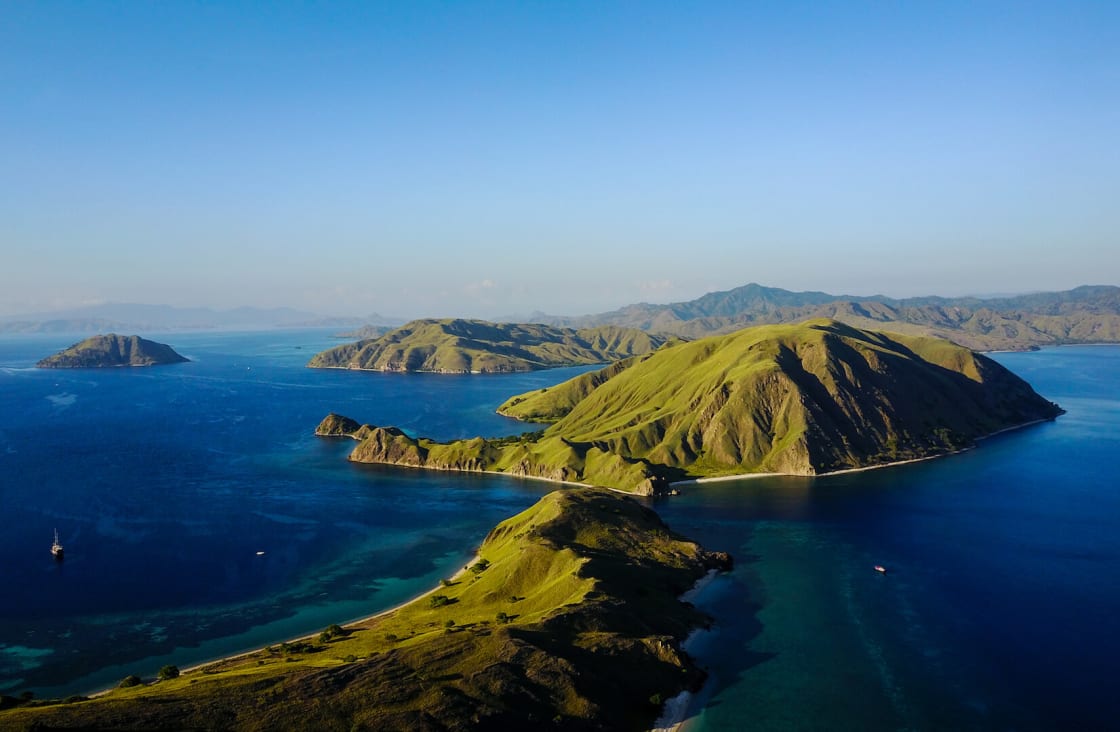
If you had to choose between diving Komodo and diving Raja Ampat, which would you choose? Which is best? Both are stellar locations; Komodo is unique due to the top side dragons, and it has fabulous diving. Raja Ampat is gorgeous topside, and you can see birds of paradise here, as well as experiencing amazing diving. The schools of fish in Raja Ampat are plentiful.
Komodo is cheaper, easier and quicker to get to, a mere 75-minute domestic flight from Bali to Labuan Bajo, with several flights per day. At Labuan Bajo, you’re already at the border of the national park. There are plenty of dive boats here that will take you into the park for the day. The dive sites in Komodo are close to one another, so there’s no need to spend time cruising between them. Therefore, if your time and money is limited, then Komodo is the better option, offering a great return on your effort.

The manta ray cleaning stations of Misool in Raja Ampat are best visited in its dry season.
Raja Ampat is remote yet worth every bit of the effort to get there. If you have to travel during a specific time, then you should make your choice based on which season. Komodo and Raja Ampat have opposite “dry seasons” during which the conditions are considered the best for diving. Komodo’s dry season is from April until November, while Raja Ampat’s dry season is the opposite, from November until April. Many of the Indonesian liveaboards are based in Raja Ampat for its dry season and then return to Komodo for the Komodo dry season. However, the rainy season in Komodo attracts huge schools of manta rays to the manta hotspots of Mawan, Manta Alley, and Karang Makassar aka Manta point.
Raja Ampat is located in Indonesia’s easternmost province of West Papua. From Bali, you’ll need to fly through Makassar or Jakarta to reach the port town of Sorong, which is the nearest airport to the national park. You won’t be able to stay in Sorong and dive in the national park for the day. You must either join a liveaboard, or stay in the national park. Sorong is the start point for liveaboard adventures, but if you’re planning to stay in a dive resort, you’ll need to take a 3-hour fast boat into the national park. Overall, this is a full day of travel.
Because of the remoteness of Raja Ampat, and because everything has to be transported to the islands, you can expect accommodation prices to be high. Diving is much more expensive in Raja Ampat than Komodo because of the remoteness, and this includes liveaboards because of the amount of fuel that is used, due to the vast size of the region. Liveaboard trips in Raja Ampat typically last for 10 days, and there are also several resorts in the region – Misool Eco Resort and Max Ammer’s Kri and Sorido resorts to name but a few.

Marvel at the mating dance of the Mandarinfish in Raja Ampat.
While Raja Ampat has world renowned biodiversity, Komodo too provides an extraordinary variety of sites and sightings within a standard 10-day liveaboard trip, from the cooler waters of Komodo’s Cannibal Rock and Manta Alley in the south, to the formidable currents in the Shotgun and fish pandemonium in the Cauldron in the north.
The water temperature in Komodo is surprisingly variable, ranging from 75-82°F on average. However if you were to dive the Hot Rocks aka Bubble Reef site off the still active Sangeang volcano just outside the national park, you’ll find much hotter water and streams of volcanic gases escaping through the black sand, which makes the colors from the marine life and corals really pop.
Komodo cruises visit a spectacular array of different dive environments, and a startlingly wide range of very high-quality diving within a compact area and is often described as being more fun because of the unpredictable currents. Komodo provides a plethora of big and small critters, including mantas, sharks, turtles, nudis, macro, soft and hard corals. Doing both the north and the south of the national park is a must. There’s also the chance to encounter the fascinating Komodo dragons on land, and see Komodo’s primeval landscape from the vantage point of the boat.

If you think the view of Gili Lawa in Komodo National Park looks good from above, just wait until you see it from below.
Of numerous stand out areas, Gili Lawa Laut is probably Komodo’s highlight of highlights, as it’s home to Castle Rock, one of the world’s most stunning dive sites. This is a true fishbowl where sharks, dolphins, tuna and thousands of fish can be encountered en masse. There are numerous liveaboards to choose from and also daytrips if you want to spend more time exploring on land.
Nevertheless, it is a proven scientific fact that Raja Ampat has more underwater species than anywhere else in the world, which for a diver, means there is an overabundance of big and small stuff to see. The fish density here is absolutely incredible. In fact, the Cape Kri dive site recorded the highest number of fish species ever seen in a single dive at 374.
Raja really does feel like frontier diving, complete with the opportunity for exploratory dives, which makes it a true adventure. Indeed, it has become the destination of choice for discerning divers and despite the huge effort to get there, very few divers are disappointed. The water temperature here is very consistent throughout the park and throughout most of the year; 82-84°F is normal and to be expected. Raja Ampat has some currents but on average, it is nowhere near as extreme as Komodo, which makes Raja Ampat easier for diving.

Otherworldy Wobbegong sharks are very common in Raja Ampat.
The Waigeo and Misool regions around Bird’s Head Peninsula have scores of dive sites that present a profusion of spectacular corals and critters, as well as a couple of signature manta ray cleaning stations too. Here, translucent turquoise waters lap the scorching white-sand beaches, coral reefs are identified by shining ribbons of aquamarine, and the picturesque karst islets, which pepper the coastline, form secret lagoons above water and intriguing caves and canyons below the water too. Further south lies Triton Bay, whose milky, nutrient rich waters are home to an astounding array of soft corals and macro critters.
Raja Ampat has a slight edge in terms of the variety of dive sites, but of course it is a much bigger area. The corals, particularly around Misool, are marvelous. Komodo has more sharks unless you count the Wobbegong sharks, which are very common in Raja Ampat. Raja Ampat also offers different experiences in the north and in the south. Macro diving can be fantastic in both Komodo and Raja Ampat.
If you have to make a decision about diving Komodo versus Raja Ampat—if cost were no object, your travel dates flexible, and your desired liveaboard had plenty of availability for itineraries in either locale—you might just conclude that it’s impossible to pick a definitive winner between the two because they are both mind-blowing dive destinations, each with their own unique qualities, attractions and allure.
While Rainforest Cruises aim to provide accurate and up-to-date information, we make no representations as to the accuracy or completeness of any information herein or found by following any link on this site. Rainforest Cruises cannot and will not accept responsibility for any omissions or inaccuracies, or for any consequences arising therefrom, including any losses, injuries, or damages resulting from the display or use of this information.




